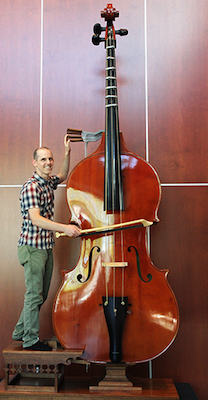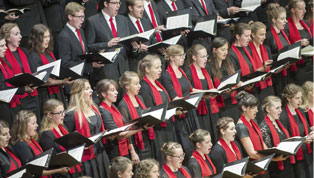KENT NAGANO CELEBRATES THE MONTRÉAL METRO
SEASON PARTNER
Maison symphonique de Montréal
In collaboration with
![]()
post-Akouma Event

October 22 concert presented by
![]()
TICKETS PRICES
8:00 PM
8:00 PM
2:30 PM
Orchestre symphonique de Montréal
Kent Nagano, conductor
Truls Mørk, cello
PROGRAM:
José Evangelista, World premiere, OSM commission to mark the metro’s 50th anniversary. (approx. 15 min.)
Schumann, Cello Concerto in A minor, op. 129 (approx. 25 min.)
Robert Normandeau, World premiere, electroacoustic work, OSM commission to mark the metro’s 50th anniversary. (approx. 10 min.)
R. Strauss, Ein Heldenleben, (A Hero’s Life) (approx. 40 min.)
Grand Preconcert Talks Our Cheeses:
Thursday, October 20, 7:00 PM
Saturday, October 22, 7:00 PM
Sunday, October 23, 1:30 PM
Host: Matthieu Dugal
Guest: José Evangelista, composer
Robert Normandeau, composer
Creativity and innovation: an OSM commission to mark the metro’s 50th anniversary.

Measuring over 12 feet, the octobass is the largest and the deepest of stringed instruments. The OSM is the only orchestra in the world to have the privilege to include this rare instrument in its ranks.
Attend this concert to hear the sound of this magnificent instrument.
The Octobass was generously loaned by patrons Huguette and Roger Dubois of Canimex.
CONCERT NOTES
Works
“Celebration” might well be the keynote for this program. Two Montreal composers celebrate fifty years of the city’s Metro system in highly-contrasting new works written expressly for the OSM. Schumann’s Cello Concerto celebrates the warmly romantic, opulent sound of the solo instrument for which it was written. And in Strauss’s tone poem Ein Heldenleben, an imaginary (or perhaps real) hero is celebrated in a lavish panoply of sensational sound effects from a giant orchestra.
José Evangelista
Born in Valencia, Spain, August 5, 1943. He’s currently living in Montreal.
Accelerando
Accelerando is a work commissioned by the OSM to mark the 50th anniversary of the Montreal Metro. Centered on the idea of movement, this music for orchestra made reference to the movement of an engine that starts up, which takes off. Also, acceleration, movement forward, evokes the progress. José Evangelista wanted to celebrate the development achieved during the 50 years of the Montreal metro.
The work revolves around a melody treated cyclically: end goes with his start and then it starts again. We could see a parallel with the movement of the metro which starts from one station to the other. Harmonic color is intimately linked to the melodic conception of the work. It’s the horizontal dimension (melody), which becomes vertically (harmony). About the pace, acceleration is changing between 40 and 132 beats per minute, which helps create the impression of a perpetual movement. Finally, on the anecdotal level, José Evangelista suggests in the melody some of the familiar sounds of our metro, you will probably know. (José Evangelista)
Robert Schumann
Born in Zwickau, June 8, 1810. Died in Endenich, July 29, 1856.
Cello Concerto in A minor, Op. 129
1. Nicht zu schnell 2. Langsam 3. Sehr lebhaft (played without pause)
In high spirits, Schumann arrived in Düsseldorf in September of 1850 to take up the post of conductor of the Music Society there. The warm reception the city afforded him, plus the anticipation of having his own orchestra to work with, seem to have revived Schumann’s interest in writing for this medium. In a feverish burst of creativity, he wrote the Cello Concerto (in just fifteen days), his Third Symphony (Rhenish), and other works, all in the remaining weeks of 1850. His wife Clara declared the concerto to be written “in true cello style.” A year after it was completed, she wrote in her diary that “I have played Robert’s cello concerto again [on the piano] and thus given myself a truly musical and happy hour. The romantic quality, the weaving of cello and orchestra are indeed wholly ravishing, and what euphony and deep feeling one finds in all the melodic passages!” Nevertheless, the composer never heard the work. Its first performance took place posthumously in Leipzig at a concert honoring his fiftieth birthday in 1860.
The concerto is imbued throughout with Schumann’s characteristic soaring romanticism and poetic beauty. Though laid out in the traditional three movements (fast – slow ̶ fast), the concerto reveals the experimental side of Schumann’s nature in the use of transitional passages linking the movements. The bridge between the second and third movements consists of material heard in the first movement. A further departure from the classical norm is seen in the omission of an orchestral exposition. The rapturous first theme of the soloist, occurring after just a few preparatory chords from the orchestra, sets the cello firmly in the spotlight. The orchestra rises to prominence only rarely, but such is the passionate fervor of the solo part that the absence of a significant orchestral contribution is hardly noted. The virtuosic finale provides an effective contrast to the earlier lyrical movements, though a pervasive rhythmic pattern does tend to become overworked.
Robert Normandeau
Born in Quebec City in 1955. He’s currently living in Montréal.
Tunnel azur
OSM audiences rarely have the opportunity to hear music by a composer who specializes in electroacoustic music. In 1992, Robert Normandeau received the first doctorate in electroacoustic music ever bestowed by the Université de Montréal, where has been teaching since 1999. Over the past thirty years, Normandeau has composed some fifty works of this type, twenty of which have won prizes in local, national and international competitions. In 1987, he was a cofounder of the Communauté électroacoustique canadienne, and in 1991 of the Réseaux. On one level his music may seem static, but on another it consists of a continuously evolving sound world moving through time.
“Cinema for the ear with the Metro as the main character – a deep and mysterious space, something unknown and fearful, subterranean and cavernous,” is how the composer describes Tunnel azur, and “it generates a feeling of suspense with its deep, low sounds.” To this end, Normandeau has incorporated into the orchestra a creature known as the octobass – a super-sized double bass, which is presented on the stage of the Maison symphonique in a world premiere. Metro riders will recognize the word “azur” as a reference to the sleek new trains that first went into service last February. Shortly thereafter, Normandeau composed Tunnel azur in his studio and saw its first presentation (in stereo sound) on August 11 at an outdoor concert in the Parterre du Quartier des spectacles in Montreal.
Richard Strauss
Born in Munich, June 11, 1864. Died in Garmish-Partenkirchen, September 8, 1949.
Ein Heldenleben, op. 40
[A Hero’s Life]
A mere glance at the number of musicians required for Ein Heldenleben (A Hero’s Life), as well as the title itself, suggest that this work will provide an unusually exciting listening experience. Indeed, Ein Heldenleben is replete with opulent sounds, glowing orchestration, huge climaxes, enormous energy and a veritable kaleidoscope of tonal colors. The orchestral forces constitute one of the largest Strauss ever employed for a purely instrumental work.
The hero of the title is usually identified as the composer himself (Strauss could never be accused of modesty!), but it would be wrong to regard the work merely as an exercise in self-aggrandizement. True, there are specific passages with autobiographical associations, but most of the work is more legitimately seen in light of a “general and free ideal of great and manly heroism … that heroism which describes the inward battle of life and which aspires through inward battle of life and which aspires through effort and reunification towards the elevation of the soul.” (Strauss)
The fifty-minute tone poem was written in late 1898 and first performed on March 3, 1899 in Frankfurt, Strauss conducting. It might be interesting to note that an obscure Danish composer by the name of Christian Frederik Emil Horneman (1840-1906) also wrote a work called Ein Heldenleben (a concert overture) and that the prominent Canadian composer R. Murray Schafer composed a modern-day parody of Strauss’s original called Son of Heldenleben for the OSM in 1968.
The six sections, all connected except for the pause ending the first, run as follows:
I. The Hero ̶ whose energetic principal theme sweeps up magnificently from the depths of the orchestra across a span of nearly three octaves.
II. The Hero’s Adversaries ̶ specifically Strauss’s critics, who are uncharitably depicted in angular, disjointed, dissonant, confused music, with such performance directions as “snarling,” “cutting and pointed” and “hissing.” The two tubas solemnly state a four-note motif that incorporates a bête noir of traditional harmonic practice, the progression of parallel fifths.
III. The Hero’s Companion ̶ Strauss’s capricious, domineering wife Pauline is portrayed by the solo violin in a series of cadenzas. “She’s very complex,” Strauss explained, “very much a woman, never twice alike.” A richly scored love scene ensues, but is spoiled at the end by a return visit from the malicious critics.
IV. The Hero’s Battlefield ̶ Three offstage trumpets sound the call to battle. Our hero leaps up, ready for action. In one of the most celebrated battle scenes in all music, Strauss depicts the hero, wife at his side, bravely fending off his assailants in a riot of orchestral colors and effects. The scene is one of great chaos and purposefully ugly sounds. The enemies are finally routed, and a sumptuous victory song ensues, with all eight horns in unison joining in for the triumphant, climactic moment.
V. The Hero’s Works of Peace ̶ a retrospective tapestry of thirty-one motifs from nine previous Strauss compositions, including six tone poems, two songs and the opera Guntram. (Complete details can be found in Norman Del Mar’s study, Vol. I.) The hero slips into a deep reverie, but one last bout with a surly critic is still to come. Flaring up in anger, he crushes his opponent decisively.
VI. The Hero’s Retreat from the World and Fulfillment ̶ A serene ending to the hero’s life is marred only by a brief memory of critics – “the impression of a bad dream experienced by an old man dozing in his armchair,” as Del Mar puts it. The wife (solo violin again) returns to comfort him, and remains to the end in a tenderly moving dialogue with solo horn, each instrument reaching its own fulfillment on high (violin) and low (horn) E-flats. One final, monumental presentation of the hero theme, played by brass and woodwinds, sends the hero on his way to another world.
© Robert Markow
Translated from English by Marc Hyland
THIS CONCERT SERIES:
Thursday Grand Concerts 1
Air Canada OSM Saturday Evenings
Musical Sundays
YOU WILL ALSO LIKE
* Prices, artists, repertoire, and, concert dates and times may be modified without notice.
Prices include a non-refundable service fee of $9.00 per ticket. Some handling fee may be charged.





